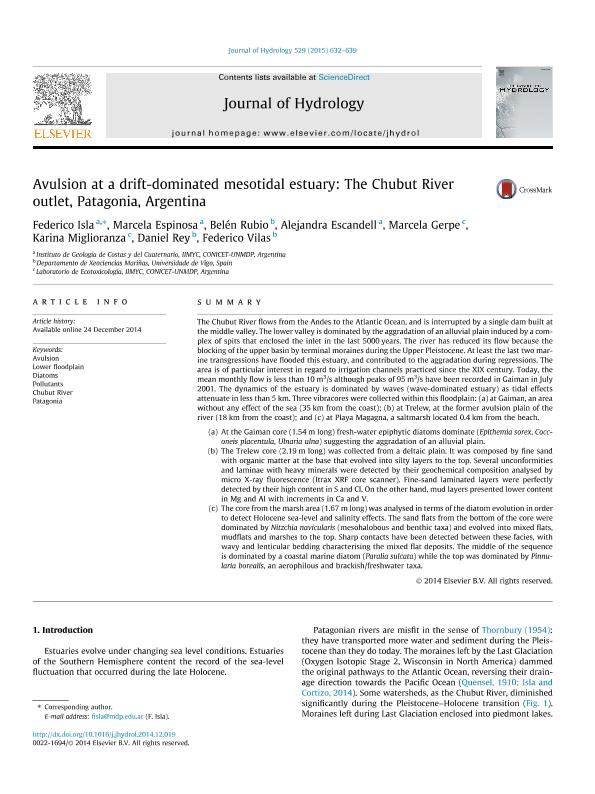Artículo
Avulsion at a drift-dominated mesotidal estuary: The Chubut River outlet, Patagonia, Argentina
Isla, Federico Ignacio ; Espinosa, Marcela Alcira
; Espinosa, Marcela Alcira ; Rubio, Belén; Escandell, Alejandra
; Rubio, Belén; Escandell, Alejandra ; Gerpe, Marcela; Miglioranza, Karina; Rey, Daniel; Vilas, Federico
; Gerpe, Marcela; Miglioranza, Karina; Rey, Daniel; Vilas, Federico
 ; Espinosa, Marcela Alcira
; Espinosa, Marcela Alcira ; Rubio, Belén; Escandell, Alejandra
; Rubio, Belén; Escandell, Alejandra ; Gerpe, Marcela; Miglioranza, Karina; Rey, Daniel; Vilas, Federico
; Gerpe, Marcela; Miglioranza, Karina; Rey, Daniel; Vilas, Federico
Fecha de publicación:
10/2015
Editorial:
Elsevier Science
Revista:
Journal Of Hydrology
ISSN:
0022-1694
Idioma:
Inglés
Tipo de recurso:
Artículo publicado
Clasificación temática:
Resumen
The Chubut River flows from the Andes to the Atlantic Ocean, and is interrupted by a single dam built at the middle valley. The lower valley is dominated by the aggradation of an alluvial plain induced by a complex of spits that enclosed the inlet in the last 5000years. The river has reduced its flow because the blocking of the upper basin by terminal moraines during the Upper Pleistocene. At least the last two marine transgressions have flooded this estuary, and contributed to the aggradation during regressions. The area is of particular interest in regard to irrigation channels practiced since the XIX century. Today, the mean monthly flow is less than 10m3/s although peaks of 95m3/s have been recorded in Gaiman in July 2001. The dynamics of the estuary is dominated by waves (wave-dominated estuary) as tidal effects attenuate in less than 5km. Three vibracores were collected within this floodplain: (a) at Gaiman, an area without any effect of the sea (35km from the coast); (b) at Trelew, at the former avulsion plain of the river (18km from the coast); and (c) at Playa Magagna, a saltmarsh located 0.4km from the beach.(a)At the Gaiman core (1.54m long) fresh-water epiphytic diatoms dominate (Epithemia sorex, Cocconeis placentula, Ulnaria ulna) suggesting the aggradation of an alluvial plain.(b)The Trelew core (2.19m long) was collected from a deltaic plain. It was composed by fine sand with organic matter at the base that evolved into silty layers to the top. Several unconformities and laminae with heavy minerals were detected by their geochemical composition analysed by micro X-ray fluorescence (Itrax XRF core scanner). Fine-sand laminated layers were perfectly detected by their high content in S and Cl. On the other hand, mud layers presented lower content in Mg and Al with increments in Ca and V.(c)The core from the marsh area (1.67m long) was analysed in terms of the diatom evolution in order to detect Holocene sea-level and salinity effects. The sand flats from the bottom of the core were dominated by Nitzchia navicularis (mesohalobous and benthic taxa) and evolved into mixed flats, mudflats and marshes to the top. Sharp contacts have been detected between these facies, with wavy and lenticular bedding characterising the mixed flat deposits. The middle of the sequence is dominated by a coastal marine diatom (Paralia sulcata) while the top was dominated by Pinnularia borealis, an aerophilous and brackish/freshwater taxa.
Palabras clave:
Avulsion
,
Lower Floodplain
,
Diatoms
,
Pollutants
Archivos asociados
Licencia
Identificadores
Colecciones
Articulos(IIMYC)
Articulos de INSTITUTO DE INVESTIGACIONES MARINAS Y COSTERAS
Articulos de INSTITUTO DE INVESTIGACIONES MARINAS Y COSTERAS
Citación
Isla, Federico Ignacio; Espinosa, Marcela Alcira; Rubio, Belén; Escandell, Alejandra; Gerpe, Marcela; et al.; Avulsion at a drift-dominated mesotidal estuary: The Chubut River outlet, Patagonia, Argentina; Elsevier Science; Journal Of Hydrology; 529; P2; 10-2015; 632-639
Compartir
Altmétricas



